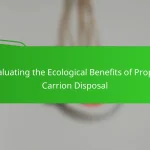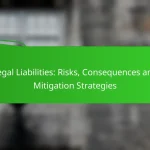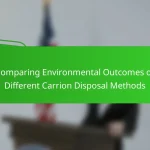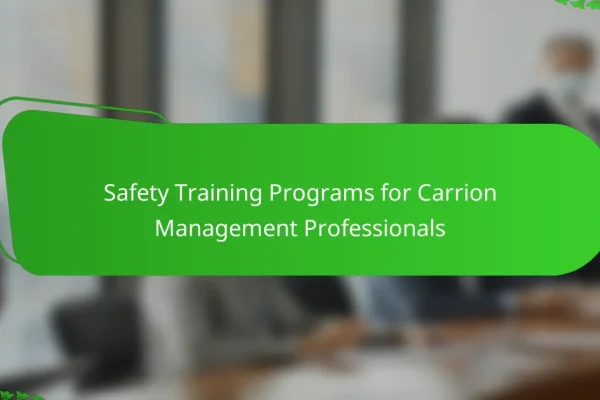What are the best practices for carrion management safety protocols in urban areas?
The best practices for carrion management safety protocols in urban areas include regular inspections, immediate removal of deceased animals, and proper use of personal protective equipment (PPE). These measures help prevent health risks and maintain public safety while ensuring compliance with local regulations.
Regular inspections and monitoring
Regular inspections and monitoring are crucial for effective carrion management. Urban areas should implement routine checks in parks, streets, and other public spaces to identify and address carrion promptly. Inspections should occur at least weekly, or more frequently in high-traffic areas.
Utilizing technology, such as surveillance cameras or mobile apps for reporting, can enhance monitoring efforts. Engaging community members to report sightings can also improve response times and overall management efficiency.
Immediate removal procedures
Immediate removal procedures are essential to minimize health risks associated with carrion. Once identified, deceased animals should be removed within a few hours to prevent disease transmission and unpleasant odors. Local authorities should establish clear protocols for notifying the appropriate services for swift action.
In urban settings, having designated teams or contracted services for carrion removal can streamline the process. It’s important to ensure that these teams are trained and equipped to handle various types of animals safely.
Personal protective equipment (PPE) usage
Proper use of personal protective equipment (PPE) is vital for the safety of personnel involved in carrion management. Workers should wear gloves, masks, and protective clothing to prevent exposure to pathogens and harmful substances. The type of PPE may vary based on the size and condition of the animal being handled.
Regular training on PPE usage and maintenance is necessary to ensure that all personnel understand how to protect themselves effectively. This includes proper disposal of PPE after use to avoid contamination.
Training for personnel
Training for personnel involved in carrion management is critical to ensure safety and compliance with protocols. Training programs should cover identification of carrion, safe handling practices, and emergency response procedures. Regular refresher courses can help keep staff updated on best practices and any changes in regulations.
Incorporating hands-on training and simulations can enhance learning outcomes. This practical approach allows personnel to gain confidence and competence in managing carrion safely.
Community awareness programs
Community awareness programs play a significant role in effective carrion management. Educating the public about the importance of reporting deceased animals and the associated health risks can lead to quicker responses. Programs can include workshops, informational flyers, and social media campaigns to reach a wider audience.
Encouraging community involvement fosters a sense of responsibility and can improve overall public health. Providing clear guidelines on how to report carrion and what to do when encountering it can empower residents to take action.
How can municipalities implement effective carrion management strategies?
Municipalities can implement effective carrion management strategies by developing structured response plans, fostering partnerships with local agencies, and utilizing technology for tracking and reporting. These strategies ensure timely and efficient handling of animal carcasses, minimizing health risks and environmental impacts.
Developing a response plan
A well-defined response plan is crucial for effective carrion management. This plan should outline procedures for identifying, reporting, and disposing of animal carcasses, including designated personnel and timelines for response. Regular training and drills can help ensure that all team members are familiar with their roles.
Consider including a checklist of steps to follow when a carcass is reported, such as assessing the location, determining the type of animal, and coordinating with waste disposal services. This structured approach can streamline the process and reduce response times.
Establishing partnerships with local agencies
Collaboration with local agencies, such as animal control, public health departments, and waste management services, enhances the effectiveness of carrion management. Establishing clear communication channels and responsibilities among these agencies can facilitate quicker responses and more efficient resource use.
Municipalities should consider formal agreements that outline roles and responsibilities in carrion management. This can include shared resources, such as equipment or personnel, and joint training sessions to ensure all parties are prepared to act swiftly when needed.
Utilizing technology for tracking
Technology plays a vital role in modern carrion management. Utilizing GPS tracking and mobile reporting applications can help municipalities monitor carcass locations and manage disposal routes more efficiently. This technology can also provide real-time data for better decision-making.
Municipalities should explore software solutions that allow for easy reporting and tracking of carcasses by the public and municipal workers alike. Implementing a centralized database can help in analyzing trends and improving future response strategies.
What are the legal requirements for carrion management in the United States?
The legal requirements for carrion management in the United States vary by federal, state, and local regulations. These laws are designed to ensure public health and environmental safety when dealing with animal carcasses.
Federal regulations overview
At the federal level, the U.S. Department of Agriculture (USDA) and the Environmental Protection Agency (EPA) set guidelines for the disposal of animal carcasses. The USDA’s Animal and Plant Health Inspection Service (APHIS) regulates the management of livestock carcasses to prevent disease spread.
Key federal regulations include the proper disposal methods such as incineration, composting, or rendering. Compliance with these regulations is crucial for maintaining biosecurity and protecting public health.
State-specific guidelines
Each state has its own set of guidelines that may expand upon federal regulations. These guidelines often address specific disposal methods, reporting requirements, and timelines for carcass removal. For example, some states may require immediate reporting of large animal deaths to local authorities.
It’s essential for individuals and businesses to familiarize themselves with their state’s regulations to avoid penalties. State agencies typically provide resources and contact information for assistance in understanding these requirements.
Local ordinances and compliance
Local governments may implement ordinances that further dictate how carrion should be managed within their jurisdictions. These ordinances can include specific disposal sites, local health department notifications, and community education programs.
Compliance with local laws is critical, as violations can lead to fines or legal action. Residents should check with their local health department or municipal office to ensure adherence to all applicable ordinances regarding carrion management.
What are the risks associated with improper carrion management?
Improper carrion management poses significant risks, including public health hazards, environmental damage, and legal repercussions. Addressing these issues is crucial for maintaining community safety and ecological balance.
Public health hazards
Improper disposal of carrion can lead to the spread of diseases among humans and animals. Pathogens from decaying organic matter can contaminate water sources and soil, increasing the risk of zoonotic diseases.
Common health risks include bacterial infections, such as salmonella and E. coli, which can arise from exposure to contaminated environments. Ensuring proper management practices can significantly reduce these health threats.
Environmental impact
The environmental consequences of poor carrion management can be severe, affecting local ecosystems. Decomposing animals can release harmful substances into the soil and waterways, disrupting habitats and harming wildlife.
For example, nutrient overload from decaying matter can lead to algal blooms in nearby water bodies, resulting in oxygen depletion and fish kills. Implementing effective disposal methods is essential to minimize these ecological impacts.
Legal repercussions
Failure to manage carrion properly can result in legal consequences, including fines and penalties. Many jurisdictions have regulations governing the disposal of animal remains to protect public health and the environment.
Violating these regulations can lead to significant financial liabilities and damage to an organization’s reputation. It is vital to stay informed about local laws and adhere to best practices in carrion management to avoid such repercussions.
What tools and technologies enhance carrion management safety?
Effective carrion management safety relies on various tools and technologies that streamline processes and reduce risks. Key innovations include drone surveillance systems, which provide real-time monitoring, and advanced waste processing technologies that ensure safe disposal.
Drone surveillance systems
Drone surveillance systems play a crucial role in enhancing carrion management safety by offering aerial monitoring capabilities. These systems can quickly cover large areas, allowing for the rapid identification of carrion locations and potential hazards.
When using drones, operators should consider factors such as flight regulations, battery life, and camera resolution. Many drones can operate for about 20 to 30 minutes before needing a recharge, so planning flight paths is essential for effective monitoring.
Additionally, integrating drones with GPS and thermal imaging can improve detection accuracy, especially in remote or hard-to-reach areas. This technology not only increases safety but also helps in efficient resource allocation for carrion removal operations.








